无线电能传输技术
无线电能传输技术研究
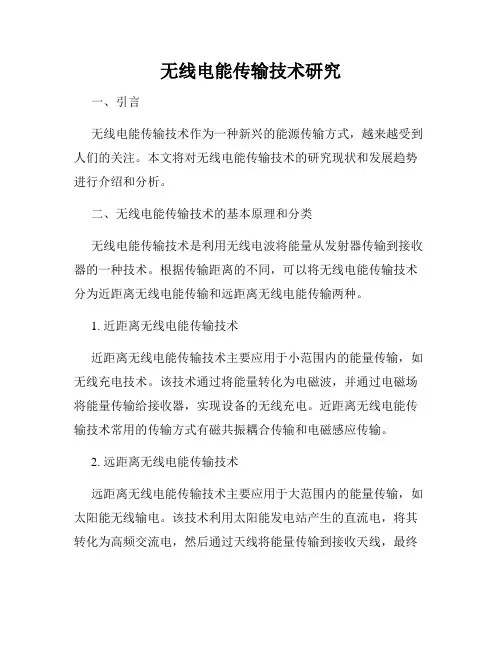
无线电能传输技术研究一、引言无线电能传输技术作为一种新兴的能源传输方式,越来越受到人们的关注。
本文将对无线电能传输技术的研究现状和发展趋势进行介绍和分析。
二、无线电能传输技术的基本原理和分类无线电能传输技术是利用无线电波将能量从发射器传输到接收器的一种技术。
根据传输距离的不同,可以将无线电能传输技术分为近距离无线电能传输和远距离无线电能传输两种。
1. 近距离无线电能传输技术近距离无线电能传输技术主要应用于小范围内的能量传输,如无线充电技术。
该技术通过将能量转化为电磁波,并通过电磁场将能量传输给接收器,实现设备的无线充电。
近距离无线电能传输技术常用的传输方式有磁共振耦合传输和电磁感应传输。
2. 远距离无线电能传输技术远距离无线电能传输技术主要应用于大范围内的能量传输,如太阳能无线输电。
该技术利用太阳能发电站产生的直流电,将其转化为高频交流电,然后通过天线将能量传输到接收天线,最终转化为直流电。
远距离无线电能传输技术常用的传输方式有微波传输和激光传输。
三、无线电能传输技术的应用领域无线电能传输技术具有广泛的应用领域,以下是一些常见的应用领域:1. 智能家居无线电能传输技术可以在家庭内实现智能家居设备的无线充电,提高家庭用电的便利性和安全性。
2. 移动通信无线电能传输技术可以为移动通信设备提供长时间的续航能力,减少用户频繁充电的困扰。
3. 无人机与机器人无线电能传输技术可以为无人机和机器人等设备提供能源支持,延长其工作时间和工作距离。
4. 新能源领域无线电能传输技术可以解决新能源发电和输电的难题,提高能源利用效率和节能减排效果。
四、无线电能传输技术的发展趋势无线电能传输技术在不断发展壮大的同时,也面临一些挑战和发展趋势。
1. 传输效率的提高目前无线电能传输技术的传输效率还不高,需要进一步提高能量传输的效率,降低能量在传输过程中的损耗。
2. 安全性的增强无线电能传输技术涉及到大量的能源传输和电磁波的产生与传输,需要加强对无线电波辐射对人体和环境的安全性研究和保障。
无线电能传输的技术研究
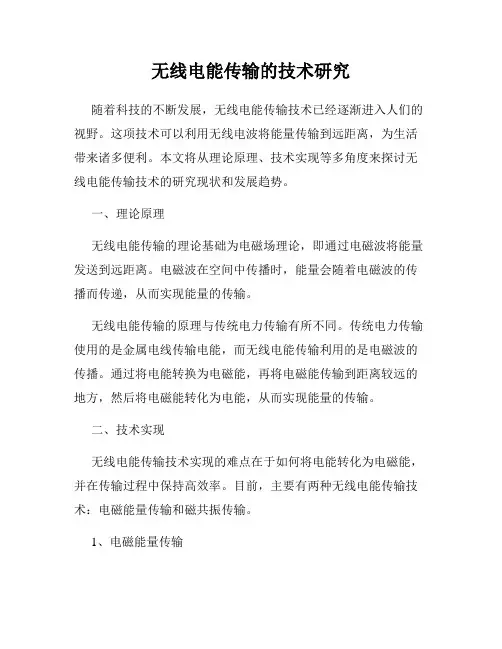
无线电能传输的技术研究随着科技的不断发展,无线电能传输技术已经逐渐进入人们的视野。
这项技术可以利用无线电波将能量传输到远距离,为生活带来诸多便利。
本文将从理论原理、技术实现等多角度来探讨无线电能传输技术的研究现状和发展趋势。
一、理论原理无线电能传输的理论基础为电磁场理论,即通过电磁波将能量发送到远距离。
电磁波在空间中传播时,能量会随着电磁波的传播而传递,从而实现能量的传输。
无线电能传输的原理与传统电力传输有所不同。
传统电力传输使用的是金属电线传输电能,而无线电能传输利用的是电磁波的传播。
通过将电能转换为电磁能,再将电磁能传输到距离较远的地方,然后将电磁能转化为电能,从而实现能量的传输。
二、技术实现无线电能传输技术实现的难点在于如何将电能转化为电磁能,并在传输过程中保持高效率。
目前,主要有两种无线电能传输技术:电磁能量传输和磁共振传输。
1、电磁能量传输电磁能量传输是指利用电磁波将能量传输到远距离,然后在接收端将电磁波转化为电能。
这种技术主要应用于低功率设备和电子产品的无线充电。
电磁能量传输通常使用的频率为20kHz~2MHz,根据频率的不同,可以实现短距离和远距离的无线电力传输。
2、磁共振传输磁共振传输是通过共振现象将能量传输到远距离。
磁共振传输需要使用两个谐振器,在接收端的谐振器和发送端的谐振器之间建立无线电场,当两个谐振器的电磁场发生共振时,能量就会传输到接收端。
这种技术可以实现更大功率的无线电力传输,但其效率较低。
三、发展趋势当前,无线电能传输技术仍处于研究和发展阶段。
未来,无线电能传输技术将带来更多的应用和发展机会。
1、智能家居随着智能家居的兴起,无线电能传输技术可以应用于智能家居的电力供应。
由于智能家居设备种类和数量的增加,这种无线电力传输技术可以实现便捷的电力供应,使得智能家居更加智能化和方便。
2、无人驾驶无人驾驶是未来自动驾驶技术的一个重要领域,而无线电能传输技术可以应用于无人驾驶汽车的电力供应。
无线电能传输技术国内外研究综述
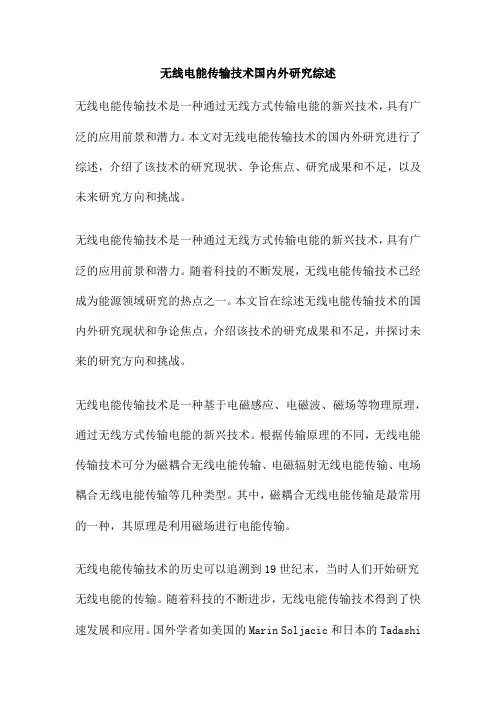
无线电能传输技术国内外研究综述无线电能传输技术是一种通过无线方式传输电能的新兴技术,具有广泛的应用前景和潜力。
本文对无线电能传输技术的国内外研究进行了综述,介绍了该技术的研究现状、争论焦点、研究成果和不足,以及未来研究方向和挑战。
无线电能传输技术是一种通过无线方式传输电能的新兴技术,具有广泛的应用前景和潜力。
随着科技的不断发展,无线电能传输技术已经成为能源领域研究的热点之一。
本文旨在综述无线电能传输技术的国内外研究现状和争论焦点,介绍该技术的研究成果和不足,并探讨未来的研究方向和挑战。
无线电能传输技术是一种基于电磁感应、电磁波、磁场等物理原理,通过无线方式传输电能的新兴技术。
根据传输原理的不同,无线电能传输技术可分为磁耦合无线电能传输、电磁辐射无线电能传输、电场耦合无线电能传输等几种类型。
其中,磁耦合无线电能传输是最常用的一种,其原理是利用磁场进行电能传输。
无线电能传输技术的历史可以追溯到19世纪末,当时人们开始研究无线电能的传输。
随着科技的不断进步,无线电能传输技术得到了快速发展和应用。
国外学者如美国的Marin Soljacic和日本的TadashiMaeda等人在该领域做出了重要贡献。
国内对无线电能传输技术的研究起步较晚,但进展迅速,已有多所高校和科研机构在该领域进行了深入研究。
目前,无线电能传输技术已经得到了广泛应用,例如无接触充电、无线电力传输网络、医疗植入式设备等。
然而,无线电能传输技术仍存在一些争论焦点和挑战,如传输效率、安全性和距离等问题。
同时,该技术的应用也需要解决一些法律和技术规范等方面的问题。
国内外学者在无线电能传输技术方面进行了大量研究,并取得了一系列重要成果。
例如,Marin Soljacic等人利用磁耦合原理实现了远距离的无线电能传输;Tadashi Maeda等人研究出了基于电磁波的无线电能传输技术,实现了高效的无线电能传输。
国内一些高校和科研机构在无线电能传输技术方面也取得了重要进展,如南京航空航天大学的陈仁文教授团队在无接触充电方面进行了深入研究,并研制出了一系列无接触充电装置。
无线电能传输技术的原理与应用
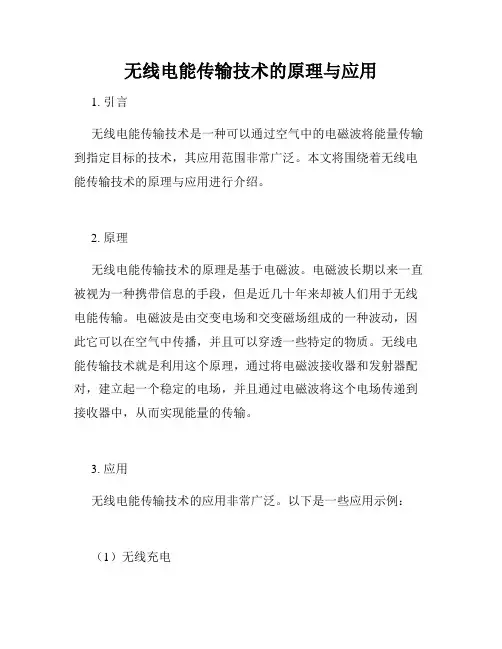
无线电能传输技术的原理与应用1. 引言无线电能传输技术是一种可以通过空气中的电磁波将能量传输到指定目标的技术,其应用范围非常广泛。
本文将围绕着无线电能传输技术的原理与应用进行介绍。
2. 原理无线电能传输技术的原理是基于电磁波。
电磁波长期以来一直被视为一种携带信息的手段,但是近几十年来却被人们用于无线电能传输。
电磁波是由交变电场和交变磁场组成的一种波动,因此它可以在空气中传播,并且可以穿透一些特定的物质。
无线电能传输技术就是利用这个原理,通过将电磁波接收器和发射器配对,建立起一个稳定的电场,并且通过电磁波将这个电场传递到接收器中,从而实现能量的传输。
3. 应用无线电能传输技术的应用非常广泛。
以下是一些应用示例:(1)无线充电无线电能传输技术最常见的应用之一就是无线充电。
现在,越来越多的智能设备都支持无线充电,例如智能手机、智能手表和智能家居设备等。
通过无线电能传输技术,这些设备可以在不需要接触任何电线或插头的情况下进行充电。
(2)工业领域无线电能传输技术还广泛应用于工业领域。
例如,可以利用这个技术无线传输能量到遥远的机器人或者深海探测设备上。
(3)医疗领域无线电能传输技术在医疗领域也有一定的应用。
例如,可以通过这种技术在炎症或癌症区域内部输送能量,以加速治疗。
(4)智能家居在智能家居领域,无线电能传输技术也有很多应用。
例如,可以通过这种技术让家具自动充电,从而避免使用电线。
4. 未来展望尽管无线电能传输技术已经发展了很长时间,但是它在未来的发展仍然有着不可估量的潜力。
例如,可以通过这种技术为移动设备和车辆提供无线充电,从而让人们在平日里更充满活力和更不依赖于插座。
另外,无线电能传输技术在有限的范围内也可以用来供电,从而为全球提供更加独立和平衡的能源方案。
5. 结论无线电能传输技术是一种非常令人振奋的技术,它将能源输送高科技化。
它不仅为我们提供了更便捷的充电方案,而且也为我们提供了一个更加绿色、更加清洁和更加可持续的未来。
无线电能传输技术在电力系统中的应用研究
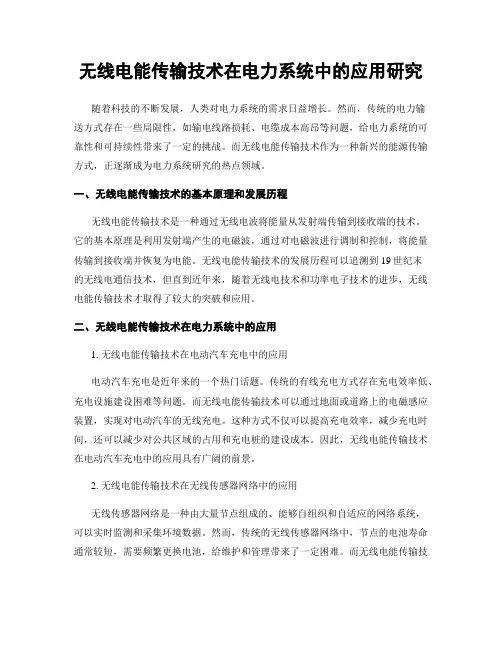
无线电能传输技术在电力系统中的应用研究随着科技的不断发展,人类对电力系统的需求日益增长。
然而,传统的电力输送方式存在一些局限性,如输电线路损耗、电缆成本高昂等问题,给电力系统的可靠性和可持续性带来了一定的挑战。
而无线电能传输技术作为一种新兴的能源传输方式,正逐渐成为电力系统研究的热点领域。
一、无线电能传输技术的基本原理和发展历程无线电能传输技术是一种通过无线电波将能量从发射端传输到接收端的技术。
它的基本原理是利用发射端产生的电磁波,通过对电磁波进行调制和控制,将能量传输到接收端并恢复为电能。
无线电能传输技术的发展历程可以追溯到19世纪末的无线电通信技术,但直到近年来,随着无线电技术和功率电子技术的进步,无线电能传输技术才取得了较大的突破和应用。
二、无线电能传输技术在电力系统中的应用1. 无线电能传输技术在电动汽车充电中的应用电动汽车充电是近年来的一个热门话题。
传统的有线充电方式存在充电效率低、充电设施建设困难等问题。
而无线电能传输技术可以通过地面或道路上的电磁感应装置,实现对电动汽车的无线充电。
这种方式不仅可以提高充电效率,减少充电时间,还可以减少对公共区域的占用和充电桩的建设成本。
因此,无线电能传输技术在电动汽车充电中的应用具有广阔的前景。
2. 无线电能传输技术在无线传感器网络中的应用无线传感器网络是一种由大量节点组成的、能够自组织和自适应的网络系统,可以实时监测和采集环境数据。
然而,传统的无线传感器网络中,节点的电池寿命通常较短,需要频繁更换电池,给维护和管理带来了一定困难。
而无线电能传输技术可以为无线传感器网络提供长时间稳定的能量供应,解决节点电池寿命问题,并延长无线传感器网络的使用寿命。
3. 无线电能传输技术在远程无人岛屿供电中的应用远程无人岛屿供电一直是一个难题,传统的供电方式通常需要铺设长距离的电缆,不仅造成资源浪费,还增加了维护成本。
而无线电能传输技术可以实现对远程无人岛屿的无线供电,大大降低了供电成本,提高了供电可靠性。
国内 无线电能传输技术

国内无线电能传输技术标题:中国无线电能传输技术的发展与应用一、引言无线电能传输(Wireless Power Transfer,WPT)是一种通过非物理接触方式传递电能的技术。
这种技术的发展和应用在很大程度上改变了人们的生活方式,为我们的日常生活带来了极大的便利。
在中国,无线电能传输技术的研究和应用也取得了显著的成果。
二、无线电能传输技术的基本原理无线电能传输技术主要利用电磁感应、电磁谐振等原理,将电能从电源端无线传输到负载端。
其中,电磁感应是利用两个线圈之间的磁场变化来产生电流;而电磁谐振则是通过两个具有相同谐振频率的线圈之间的能量交换来实现电能的无线传输。
三、中国无线电能传输技术的发展近年来,中国的无线电能传输技术发展迅速。
国内科研机构和企业对无线电能传输技术进行了大量的研究,并取得了一系列的重要成果。
例如,一些高校和科研机构成功研发出了高效率、大功率的无线电能传输系统,并在电动汽车充电、无人机供电等领域得到了实际应用。
四、中国无线电能传输技术的应用目前,中国的无线电能传输技术已经在多个领域得到了广泛应用。
在电动汽车充电方面,无线电能传输技术可以实现电动汽车的无接触充电,大大提高了充电的便利性。
在医疗设备供电方面,无线电能传输技术可以实现植入式医疗设备的无线供电,降低了手术风险。
此外,无线电能传输技术还在智能家居、消费电子等领域有着广阔的应用前景。
五、结论总体来看,中国的无线电能传输技术已经取得了显著的进步,并且在多个领域得到了广泛的应用。
未来,随着科技的进步和市场需求的变化,中国的无线电能传输技术将会得到进一步的发展,为人们的生活带来更多的便利。
无线电能传输技术的最新研究
无线电能传输技术的最新研究随着科技的不断发展,无线电能传输技术正逐渐成为可行的能源传输方式。
相比传统的有线电力传输,无线电能传输技术具备许多优势,例如无需铺设电缆线路、能够实现远距离传输、无污染等。
这项技术在解决能源传输难题、推动可再生能源应用以及实现智能城市等领域拥有广阔前景。
本文将介绍无线电能传输技术的最新研究进展,以及其潜在应用领域。
一、无线电能传输技术的原理无线电能传输技术基于电磁辐射的原理,通过无线电波将能量从发射器传输到接收器。
其中,发射器将电能转化为高频无线电波并辐射出去,而接收器则将无线电波再转化为电能。
重要的是,在传输过程中要保证能量的高效传递。
二、电磁共振技术在无线电能传输中的应用电磁共振技术被广泛应用于无线电能传输中,通过合理设计共振系统,可以实现较高的传输效率。
以无线充电技术为例,当发射器和接收器之间处于相同的共振频率时,能量传输效率可被大幅提高。
此外,电磁共振技术还可以应用于对接触电极无线供电、家庭设备无线充电等场景。
三、最新研究进展1. 穿透障碍物技术传统无线电能传输技术受到障碍物的限制,如墙壁、建筑物等会阻碍信号的传输。
然而,最新的研究表明,利用超声波跨障碍技术可有效进一步提高能量传输距离,并且具备较高的传输效率。
这种技术具备发展农业、医疗设备远程供电等领域的潜力。
2. 智能调控技术为了提高无线电能传输的可控性和效率,研究者们正致力于开发智能调控技术。
该技术可以根据能源需求调整发射器的功率和频率,以适应不同的环境和设备。
智能调控技术的应用将进一步推动无线电能传输技术的发展。
3. 长距离传输技术无线电能传输技术在长距离传输方面仍然面临一些挑战,如信号衰减、传输效率等。
目前,研究者们正在致力于开发高效的天线设计、信号放大和系统优化等技术来解决这些问题。
四、无线电能传输技术在实际应用中的前景1. 可再生能源的应用无线电能传输技术可以大大推动可再生能源的发展和利用。
通过将能源直接传输到需要使用的设备中,可以消除能源传输的损耗和效率低下的问题,从而提高可再生能源的利用率。
无线电能传输技术的应用与发展
无线电能传输技术的应用与发展在当今科技飞速发展的时代,无线电能传输技术正逐渐从科幻走向现实,为我们的生活带来前所未有的便利和变革。
这项技术打破了传统有线电能传输的束缚,让电能的传输不再受限于电线的连接,为众多领域带来了新的可能性。
无线电能传输技术,顾名思义,就是无需通过导线连接,就能实现电能从电源到负载的传输。
其基本原理主要包括电磁感应、电磁共振和无线电波等方式。
电磁感应式无线电能传输就如同变压器的原理,通过初级线圈和次级线圈之间的电磁感应来传递能量;电磁共振式则是让发射端和接收端的线圈在相同的频率下共振,从而实现高效的能量传输;而无线电波式则是通过发射电磁波来传递电能,但这种方式的能量传输效率相对较低,目前应用较少。
在消费电子领域,无线电能传输技术已经得到了广泛的应用。
最常见的就是无线充电手机和无线充电耳机。
想象一下,当我们回到家或者办公室,只需将手机随意放在充电板上,无需再繁琐地插拔充电线,就能让手机电量满满。
这不仅方便了我们的生活,还减少了因频繁插拔充电线而导致的接口磨损。
无线充电耳机也让我们在使用时摆脱了线缆的束缚,更加自由舒适。
此外,无线充电技术还应用于平板电脑、智能手表等设备,为我们的智能生活提供了更加便捷的能源支持。
在交通运输领域,无线电能传输技术也展现出了巨大的潜力。
电动汽车无线充电正在成为一种新兴的充电方式。
传统的电动汽车充电需要使用充电枪连接车辆和充电桩,不仅操作不便,而且在恶劣天气条件下还存在一定的安全隐患。
而无线充电技术可以让电动汽车在停车时自动进行充电,无需人工干预。
例如,一些停车场已经开始安装无线充电设施,当电动汽车停入指定位置时,就能通过地下的充电装置进行无线充电。
这不仅提高了充电的便利性,还能有效利用停车时间,增加电动汽车的续航里程。
此外,无线电能传输技术还可以应用于轨道交通,如磁悬浮列车等,为列车提供持续稳定的电能供应。
在医疗领域,无线电能传输技术也为医疗器械的发展带来了新的机遇。
无线电能传输技术
所谓无线电能传输,就是借助于电磁场或电磁波进行能量传递的一种技术。
无线输电分为:电磁感应式、电磁共振式和电磁辐射式。
电磁感应可用于低功率、近距离传输;电磁共振适于中等功率、中等距离传输;电磁辐射则可用于大功率、远距离传输。
近年来,一些便携式电器如笔记本电脑、手机、音乐播放器等移动设备都需要电池和充电。
电源电线频繁地拔插,既不安全,也容易磨损。
一些充电器、电线、插座标准也并不完全统一,这样即造成了浪费,也形成了对环境的污染。
而在特殊场合下,譬如矿井和石油开采中,传统输电方式在安全上存在隐患。
孤立的岛屿、工作于山头的基站,很困难采用架设电线的传统配电方式。
在上述情形下,无线输电便愈发显得重要和迫切,因而它被美国《技术评论》杂志评选为未来十大科研方向之一。
在此旨在阐述当前的技术进展,分析无线输电原理。
1 无线电能传输技术的发展历程最早产生无线输能设想的是尼古拉·特斯拉(Nikola Tesla),因而有人称之为无线电能传输之父。
1890年,特斯拉就做了无线电能传输试验。
特斯拉构想的无线电能传输方法是把地球作为内导体,把地球电离层作为外导体,通过放大发射机以径向电磁波振荡模式,在地球与电离层之间建立起大约8 Hz的低频共振,利用环绕地球的表面电磁波来传输能量。
最终因财力不足,特斯拉的大胆构想没能实现。
其后,古博(Goubau)、施瓦固(Sohweing)等人从理论上推算了自由空间波束导波可达到近100%的传输效率,并随后在反射波束导波系统上得到了验证。
20世纪20年代中期,日本的H.Yagi和S.Uda发明了可用于无线电能传输的定向天线,又称为八木一宇田天线。
20世纪60年代初期雷声公司(Raytheon)的布朗(W.C.Brown)做了大量的无线电能传输研究工作,从而奠定了无线电能传输的实验基础,使这一概念变成了现实。
在实验中设计了一种效率高、结构简单的半波电偶极子半导体二极管整流天线,将频率2.45GHz的微波能量转换为了直流电。
国内 无线电能传输技术
国内无线电能传输技术的发展与应用一、引言无线电能传输(Wireless Power Transmission,简称WPT)是一种利用电磁波将电能从一个地方传输到另一个地方的技术。
近年来,随着科技的快速发展,无线电能传输技术在国内也取得了显著的进步,并在多个领域得到了广泛的应用。
二、技术原理无线电能传输主要基于电磁感应和磁共振两种方式。
电磁感应是通过变化的磁场产生电流,而磁共振则是通过两个谐振频率相同的线圈之间的能量传递。
三、国内发展现状我国在无线电能传输技术的研发方面投入了大量的资源,已取得了一系列重要的研究成果。
例如,我国已经成功研发出可以实现长距离、大功率无线输电的设备,并在电动汽车充电、无人机充电等领域进行了实际应用。
四、应用领域1. 电动汽车充电:无线电能传输技术能够实现电动汽车的无接触式充电,大大提高了充电的便利性。
2. 无人机充电:无人机可以通过无线电能传输技术进行空中充电,从而延长其飞行时间。
3. 家用电器:一些家用电器如电动牙刷、剃须刀等已经开始采用无线电能传输技术进行充电。
五、未来展望随着科技的进步,无线电能传输技术将会得到更广泛的应用。
在未来,我们有望看到更多的设备使用无线电能传输技术进行充电,这将极大地提高我们的生活便利性。
同时,无线电能传输技术也有望在空间太阳能发电、深海能源开采等领域发挥重要作用。
六、结论总体来看,无线电能传输技术在我国的发展前景十分广阔。
然而,要实现这一技术的大规模应用,还需要我们在技术研发、标准制定等方面做出更大的努力。
我们期待无线电能传输技术能够在未来的日子里为我们的生活带来更多的便利。
- 1、下载文档前请自行甄别文档内容的完整性,平台不提供额外的编辑、内容补充、找答案等附加服务。
- 2、"仅部分预览"的文档,不可在线预览部分如存在完整性等问题,可反馈申请退款(可完整预览的文档不适用该条件!)。
- 3、如文档侵犯您的权益,请联系客服反馈,我们会尽快为您处理(人工客服工作时间:9:00-18:30)。
所谓无线电能传输,就是借助于电磁场或电磁波进行能量传递的一种技术。
无线输电分为:电磁感应式、电磁共振式和电磁辐射式。
电磁感应可用于低功率、近距离传输;电磁共振适于中等功率、中等距离传输;电磁辐射则可用于大功率、远距离传输。
近年来,一些便携式电器如笔记本电脑、手机、音乐播放器等移动设备都需要电池和充电。
电源电线频繁地拔插,既不安全,也容易磨损。
一些充电器、电线、插座标准也并不完全统一,这样即造成了浪费,也形成了对环境的污染。
而在特殊场合下,譬如矿井和石油开釆中,传统输电方式在安全上存在隐患。
孤立的岛屿、工作于山头的基站,很困难采用架设电线的传统配电方式。
在上述情形下,无线输电便愈发显得重要和迫切,因而它被美国《技术评论》杂志评选为未来十大科研方向之一。
在此旨在阐述当前的技术进展,分析无线输电原理。
1无线电能传输技术的发展历程最早产生无线输能设想的是尼古拉•特斯拉(NikolaTesla),因而有人称之为无线电能传输之父。
1890年,特斯拉就做了无线电能传输试验。
特斯拉构想的无线电能传输方法是把地球作为内导体,把地球电离层作为外导体,通过放大发射机以径向电磁波振荡模式,在地球与电离层之间建立起大约8 Hz的低频共振,利用环绕地球的表面电磁波来传输能量。
最终因财力不足,特斯拉的大胆构想没能实现。
其后,古博(Goubau)、施瓦固(Sohweing)等人从理论上推算了自由空间波束导波可达到近100%的传输效率,并随后在反射波束导波系统上得到了验证。
20世纪20 年代中期,日本的H.Yagi和S.Uda发明了可用于无线电能传输的定向天线,乂称为八木一宇田天线。
20世纪60年代初期雷声公司(Raytheon)的布iM(W.C.Brown)做了大量的无线电能传输研究工作,从而奠定了无线电能传输的实验基础,使这一概念变成了现实。
在实验中设计了一种效率高、结构简单的半波电偶极子半导体二极管整流天线,将频率2.45GHz的微波能量转换为了直流电。
1977年在实验中使用GaAs—Pt 肖特基势垒二极管,用铝条构造半波电偶极子和传输线,输入微波的功率为8 W,获得了90.6%的微波一一直流电整流效率。
后来改用印刷薄膜,在频率2.45 GHz时效率达到了85%o自从Brown实验获得成功以后,人们开始对无线电能传输技术产生了兴趣。
1975 年,在美国宇航局的支持下,开始了无线电能传输地面实验的5 ail'划。
喷气发动机实验室和Lewis科研中心曾将30 kW的微波无线输送1.6 km,微波一一直流的转换效率达83%。
1991年,华盛顿ARCO电力技术公司使用频率35 GHz的毫米波,整流天线的转换效率为72% o 1998年,5.8 GHz印刷电偶极子整流天线阵转换效率为82%。
前苏联在无线电能传输方面也进行了大量的研究。
莫斯科大学与微波公司合作,研制出了一系列无线电能传输器件,其中包括无线电能传输的关键器件一一•快回旋电子束波微波整流器。
近儿年,无线电能传输发展更是迅速。
Wildchargex Powercast、SplashPower> 东京大学,相继开发出非接触式充电器。
MIT在2007年6月宣布,利用电磁共振成功地点亮了一个离电源约2 m远的60 w电灯泡,这项技术被称为WiTricityo该研究小组在实验中使用了两个直径为50 cm的铜线圈,通过调整发射频率使两个线圈在10MHz 产生共振,从而成功点亮了距离电力发射端2 m以外的一盏60 w灯泡。
2无线电能传输的原理(1)非接触电能传输系统利用疏松感应耦合系统和电力电子技术相结合的方法,实现了电能的无物理连接传输。
它将系统的变压器紧密型耦合磁路分开,初、次级绕组分别绕在具有不同磁性的结构上,实现在电源和负载单元之间进行能量传递而不需物理连接。
其一次侧、二次侧之间通过电磁感应实现电能传输,因气隙导致的耦合系数的降低山提高一次侧输入电源的频率加以补偿。
理论和经验都表明:当原边电流频率、幅值越高,原、副边距离越小,与空气相比,磁心周圉介质的相对磁导率越大时,可分离式变压器的传输效率越高。
但实际应用当中原副边距离不可能无限小,必须对原副边采取相应的补偿措施,这种无线电能传输效率较低。
(2)对无线电能传输来说,能量传递的效率是最重要的。
因此,方向性强、能量集中的激光与具有类似性质的微波束是值得考虑的选择。
但激光光束在空间传输易受到空气和尘埃的散射,非线性效应明显,且输出功率小,因此微波输能成为首选。
微波输能,就是将微波聚焦后定向发射出去,在接收端通过整流天线(rect-enna)把接收到的微波能量转化为直流电能。
布朗的微波输电系统。
上世纪60年代,William C.Brown向世人展示的微波传输电能示意图。
该微波传输系统包括微波源、发射天线、接受天线3部分。
微波源内有磁控管,能控制源在2. 45 GHz频段输出5〜200 W的功率;微波源输出的能量通过同轴电缆连接至和波导管之间的适配器上;亚铁酸盐的循环器连接在波导管上,使波导管和发射天线相匹配。
发射天线包含8个部分,每个部分上都有8个缝隙。
这64 个缝隙均匀的向外发射电磁波。
这种开孔的波导天线很适合用于无线电能传输,因为它有高达95%的孔径效率和很高的能量捕捉能力。
硅控整流二极管天线用来收集微波并把它转换成直流电,在布朗展示的系统中该接收天线拥有25%的收集和转换效率,这种天线在2.45GHz测试时曾经达到其至超过90%的效率。
传输距离较远之后, 增强天线的方向性和效率会十分困难。
微波输能的传输效率。
若D代表微波在自由空间传输的距离,A,、A-分别代表发射天线和接收天线的面积,入表示工作波长,则微波在自由空间的传输效率n 是参数2■的函数。
山公式知传输效率和传输距离没有直接的联系,而是山决定。
故距离D增大的效应V可|f| A. . A.的增加或入的减小来补偿。
微波输能的总效率等于直流到微波、微波传输和接收整流三部分效率之积。
故可知当前微波传输能量的效率还不高,但是还是很有发展潜力的。
(3)辐射性传输,虽然完全适合于传输信息,但是将其应用于电能传输却会引起很多的困难:如果辐射是全方向性的,则电能传输效率会十分的低;如果是定向辐射,也要求具有不间断可视的方位和十分复杂的追踪仪器设备,而磁谐振却没有这么复杂。
自谐振线圈的模型描述。
A是一个半径为25 cm的单匝铜环,它是激励电路的一部分,输出频率为9.9 MHz的正弦波。
S和D是自谐振线圈。
B是连接到负载(灯泡)的单匝导线环。
不同的K代表箭头表示的对象之间的直接耦合。
调整线圈D和A之间的角度,保证它们之间的直接耦合等于零。
线圈S和D同轴排列。
线圈B和A以及B和s 的直接耦合是可以忽略不计的。
强耦合磁谐振下的电能传输效率。
在耦合谐振系统(如声音、电磁、磁、核等)里,经常会产生“强耦合”运行状态。
如果处于给定系统中的这种状态,谐振体之间的能量交换则可期望达到很高的效率。
如果不考虑周圉空间的结构,并且在干涉损耗和散失在周圉环境中的损耗很低时,中等距离的能量传输用这种方法可以在接近全方向的状态下实现并达到很高的效率。
3结束语一些边远山区、牧区、高原、海岛,人口稀少,居住分散,交通不便,经济落后,那儿缺乏常规能源,乂远离大电网,严重影响当地经济发展。
这种情况下,利用微波输能技术,可以解决电网的死角。
输电工程最关心的是效率和经济性。
无线电能传输的效率取决于微波源的效率、发射/接收天线的效率和微波整流器的效率; 其经济性如何,依赖于所用频段的微波元器件的价格与有线输电系统所用器材价格的比较,也与具体的输电网络的参数有关系。
除了关心经济和效率以外,还要对大功率微波对环境和身体健康可能造成的影响进行研究,需保证如下方面:(1)传输微波能流密度不能对电离层产生明显扰动;(2)必须保证不干扰Et常通信;(3)地面整流接收站不能对飞机等交通工具及周围的生物体(如鸟类、居民等)产生不良作用。
来自:科学技术附英文原文:Wireless Transmission TechniquesThe so-called radio transmission technology is an energy transfer technique by means of electromagnetic fields or electromagnetic wave. The wireless transmission is divided into: electromagnetic induction-type, electric type and magnetic resonance electromagnetic radiation type・Electromagnetic induction can be used for low-power, short distance transmission; electric magnetic resonance is suitable for medium-power, medium-distance transmission; electromagnetic radiation can be used for high-power, long-distance transmission. In recent years, a number of portable electrical appliances such as notebook computers, mobile phones, music players and other mobile devices will need batteries and charger. Power cable plug frequently, that is neither safe, nor easy to wear and tear. Some chargers, cables, socket standards are not entirely unified.That would result in a waste and environmental pollution. And in special occasions, such as mining and oil exploration, the traditional transmission approach in terms of security risks exist. Isolated islands, the work of the hills of the base station, it is difficult to set up cables using the traditional distribution methods. In these cases, the wireless transmission will be increasingly more important and urgent, so it is the United States, ^Technology Review** magazine top ten for the future research directions・ In wireless transmission areas, our research has only just started, compared with Europe and the United States lagging behind. This sets out the current technological progress, analyze the wireless transmission principles ・1The development process of radio transmission technologyProduce the first wii'eless ti'ansmission can be emisaged is • Nikola Tesla (Nikola Tesla), which was known as the father of the radio can transmit・ In 1890, Tesla made a radio is able to carry on the experiment. Tesla idea of radio transmission method is to be able to, within the earth as a conductor, the Earths ionosphere as the outer conductor, through the amplification of electromagnetic waves transmitter to the radial oscillation mode, set up between the Earth and ionosphere of about 8 Hz low-frequency resonance the use of electromagnetic waves aroundthe Earth's surface to transmit the energy. The end of insufficient financial resources, Tesla failed to achieve a bold vision・Subsequently, the Goubau, Sohweing, who calculated the theoretical free-space beam guided wave can reach nearly 100% transmission efficiency, and subsequently reflected beam waveguide system has been verified・ 20 mid・20th century, Japans H. Yagi, and S. Uda invention can be used to transmit radio directional antenna, also known as a Yagi Uda antenna・ 60 in the early 20th century, Raytheon Company , w.C.Brown have done a lot of radio is able to carry research work, which laid the foundation of radio transmission experiments can be the basis to make this concept become a reality.In the experiment designed a high efficiency, simple structure, the half7-wave rectifier diode electric dipole antenna, the frequency of 2.45GHz microwave energy conversion to DC. 1977, used in experiments GaAs-Pt Schottky barrier diode, constructed of aluminum half-wave electric dipole and transmission lines, input microwave power of 8 W, won 90.6% of the microwave - the efficiency of DC rectifier ・Then use print film, in the frequency of 2.45 GHz when the efficiency reaches 85%・Since the Brown experiment a success, people began to radio transmission technology can produce interest. In 1975, NASA's support, began a radio transmission on the ground can experiment 5 a plan. Jet Engine Laboratory and Lewis Research Center who will be 30 kW of microwave radio transmission 1.6 km, microwave ・ DC conversion efficiency of up to 83%. In 1991, Washington, ARCO Power Technologies, Inc. 35 GHz millimeter-wave frequency, the conversion efficiency of rectenna 72%・ In 199& 5.8 GHz printed dipole rectenna array conversion efficiency is 82%・Radio is able to carry the former Soviet Union also carried out a lot of research. Moscow State University and microwave companies, developed a series of radio is able to carry devices, including radio can transmit a key device - fast cyclotron wave of e-beam microwave rectifiers ・In recent years, radio is able to carry the development of even more rapid. Wildcharge, Powercast, SplashPower, University of Tokyo have developed a non-contact type chaiger. MIT in June 2007, announced the successful use of electric magnetic resonance of a place of light from the power supply of about 2 m away 60 w light bulb, the technology is known as WiTricity. Theresearch team in experiments using two 50 cm diameter copper coils, by adjusting Hie transmission frequency to the two coils resonate at 10 MHz, thus successfully lit the distance 2 m away from the transmitter power of a 60 w bulb •2The pirnciple of radio transmission(1 ) Non-contact power transmission system, the use of loose coupling system and power electronic induction method of combining technologies to achieve the non-physical connection of the power transmission. It will compact the system transformer-coupled magnetic circuit to separate the primary and secondary windings, respectively around with different magnetic structure, achieve the power and energy transfer between the load cell without the need for physical connection. Its primary side and secondary side through electromagnetic induction between the realization of power transmission and coupling coefficients due to air gap caused by the reduction by an increase in the frequency of one side to compensate for input power.Theory and experience indicate that: When the primary side current frequency, amplitude of the higher of both sides of the smaller distance, and the air compared to the surrounding medium core relative permeability greater when the detachable transformer transfer efficiency more high・ However, when the Central Plains of both sides of the practical application of the distance can not be infinitely small, former deputy side must take appropriate compensatory measures, which the radio is able to carry less efficient.(2) On the radio can transmit, the energy transfer efficiency is the most important. Therefore, the orientation strong energy concentration in laser and microwave beams of a similar nature is worth considering options・ However, in the space laser beam transmission vulnerable to air and dust scattering, nonlinear effects are more obvious, and the output power is small, so can become the first choice of microwave transmission. Micro wave input energy, that is, after the directional microwave focusing launched, at the receiving end through the rectifier antenna (rect-enna) the received microwave energy into DC can be.Brown's microwave transmission system. The last century, 60 years, William C・ Brown to show the world the microwave transmission power diagram. The microwave transmission system, including microwave source, transmitting antenna, receiving antenna part 3. There are magnetron microwave source can control the source in the 2.45 GHz frequency band output of 5 ~ 200 W ofpower; microwave source output power through the coaxial cable connected to and between the waveguide adapter; Ferrous Salts loop device connected to the waveguide, the waveguide tube and the transmitting antenna to match・ Transmitting antenna contains eight parts, each part of the gap on both & This is a uniform gap of 64 out emit electromagnetic wave・Such openings waveguide antenna can be very suitable for radio transmission, because it has up to 95% of the aperture efficiency and liigh energy capture capabilities・ Silicon-controlled rectifier diode microwave antennas used for the collection and put it into DC, Brown demonstrated that the receiving antenna system has a 25% collection and conversion efficiency, this antenna has 2.45GHz tested to meet or exceed 90% efficiency ・After Hie transmission distance and enhance the antenna directivity and efficiency will be very difficult.Micro wave transmission energy transmission efficiency ・ If the D on behalf of microwave transmission distance in free space, At 、Ar representing the transmitting antenna and receiving antenna area, into the said operating wavelength, then the microwave in free space transmission efficiency n is the parameter r function.2廳(分 1By a formula known transmission efficiency and transmission distance is no direct link, but by the decision・ Therefore, the distance D increases the effect of V can be At、Ai of the increase or the decrease of income to compensate・ The overall efficiency of microwave energy input is equal to DC to microwave, microwave transmission and reception efficiency rectifier three-part product. Therefore, we can see the current microwave transmission of energy efficiency is not high, but it is still great potential for development.(3) Radiative transfer, though perfectly suited to transmit information, but it will be applied to energy transfer but it will give rise to many problems: If the radiation is a full-directional, then the energy transfer efficiency will be very low; if it is directional radiation, but also requires a continuous visual orientation and very complex tracking equipment, and magnetic resonance but not so complicated・Self-resonant coil model description. A is a radius of 25 cm single-turn copper ring, which is to stimulate a part of the circuit, the output frequency of 9.9 MHz sine wave・ S and D is a self-resonant coils. B is connected to the load (light bulbs) in a single turn wire loop・Representative of the different K-arrows direct coupling between the objects. Adjust the coil the angle between D and A to ensure that the direct coupling between them is zero. S and D coaxial coil arrangement. Coil B and A and B, s, the direct coupling is negligible.Under the strong-coupling magnetic resonance energy transfer efficiency・ In the coupled resonant systems (such as sound, electromagnetic, magnetic, nuclear, etc.), the often have a ''strong coupling*1operation status. If you are in a given system in this state, resonance energy exchange between the body can be expected to achieve high efficiency・ If you do not take into account the structure of the surrounding space, and interfering loss and dissipation loss in the surrounding environment is low, medium-distance power transmission using this method can be close to the direction of a state-wide implementation and achieve high efficiency・3ConclusionSome of the remote mountainous areas, pastoral areas, highlands, islands, sparsely populated, scattered habitations, inconvenient transportation, economic backwardness, where the lack of conventional energy, but also away from the large power grids, a serious impact on the local economic development. This case, the use of microwave transmission energy technologies can solve the grid corners・ Transmission Project is most concerned about the efficiency and economy. The efficiency of the radio can transmit microwave source depends on the efficiency of transmit / receive antenna efficiency and the efficiency of microwave rectifiers; its economy to rely on the components used in the price band of microwave transmission systems and cable equipment for the price comparison, but also with specific parameters of the transmission network are related.Concerning the economy and efficiency, but also for high-power microwave on the environment and the possible impact of health research, it is need to ensure the following aspects: (1) transmission of microwave energy density will not create a noticeable disturbance on the ionosphere; (2) it must be Et guarantee and will not to interfere with regular communication;(3) ground receiving stations can not have a negative effect on aircraft and other modes of transport of organisms (such as birds, people, etc.)・From: Science and Technology。
